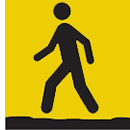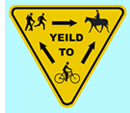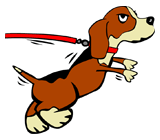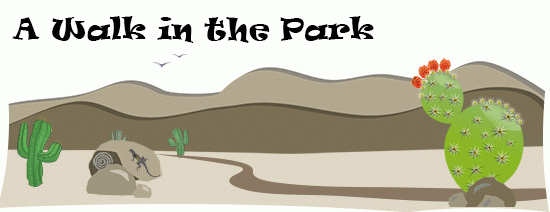show/hide words to know
Hydrate: to drink water in order to stay healthy.
Top Ten Hiking Tips
You would think living in a desert the Number 1 tip would be WATER, but actually it is Have a Plan & Stick to Your Plan.
- Why this helps: if you know the hike you are planning to take you will know what to expect, what to wear, what to pack, how long you will be gone for, and how much of everything to bring along.
- Bring or review the map of the trail route. Know the difficulty level.
Your Number 2 tip should be WATER, but what will serve you better is To Tell Someone Where you are Going and How Long you will be Gone.
-
Why this helps: if you get hurt, lost or don’t return from your hike, Search and Rescue knows where to start looking for you. Those valuable minutes /hours could mean the difference between life and death.

Tip Number 3 WATER, WATER, WATER! Pre-hydrate (drink plenty of water the night before), carry plenty of water (bring more than you think you will need, and then bring some more), and drink the water you bring.
- Why this is important: Think of your body as a sponge, if it is full of water it will readily absorb and put to work any additional water it is given. If your body is ready to receive water it will immediately put to use the water you give it as you hike.
- You never want to run out of water - a person can last days without food, but in the desert you are looking at only a few hours without water before your body starts shutting down.

Tip Number 4 Did I say WATER? It is that important that it is worth repeating twice. Water is man’s best friend when hiking; one can never have too many friends.
- Rule of thumb is to take a drink of water every 8 minutes, about a quart of water an hour.
- The harder you work, the hotter it is outside, the more water you will need to drink.
Stick to Trails makes it to the top of our hiking tips at Number 5.
- Why this is key: When you stay on the designated trail you are keeping yourself from getting lost, protecting the environment and possibly saving your life.
- Each time we walk off the trail we are encroaching on the native wildlife’s turf. We are given an invitation into their homes and we should respect it by giving them the space they deserve.

Tip Number 6 Turning Back is not Admitting Defeat. You can always come back another day, unless you can’t…
- What do we mean? Human beings like to finish what they start (unless that means cleaning anything). When hiking they like to reach their destination even if they have run out of water, have reached their endurance limit, or have run out of daylight. So listen to your body signals and heed them when they say you have had enough for one day.
- Used up half your water? Then it’s time to turn around and head back.
- Hike took longer than expected and the sun is starting to go down? Turn around and hike while you can still see the trail.
Tip Number 7, 8, & 9 Respect, Respect, Respect.
-
Respect others on the trail - give way to uphill hikers, step aside for horseback riders, keep an eye and an ear out for mountain bike riders. Everyone came out to have a great day in Nature, do not bring the noise and stress of home with you.

- Respect Wildlife by watching it from a distance, leaving it alone, and by never feeding it.
- Respect Nature by not hiking at 1 pm on a 114 degree day, by leaving it as you find it and not taking any of it home with you UNLESS it is trash, yours or others, in which case you can feel free to take all of it with you.
And the final tip in the Top Ten of Hiking Tips is Number 10 - Keep your Pets on Leash and Clean Up after Them.
- Enough Said. Okay I can say more…
- Dogs off leash can get hurt by cacti, snakes, and other wildlife.
-
Dogs off leash can hurt wildlife.

- Dogs off leash can scare horses and you do not want to be anywhere near a scared horse on a trail.
- Dogs off leash can hurt mountain bikers and other hikers.
- Dog waste left on the trails is ugly, smells, and you definitely don’t want to step in it. (Nor does anyone else)
- Okay, now, Enough Said.
View Citation
Bibliographic details:
- Article: Top 10 Tips for Hiking
- Author(s): Dr. Biology, Justin Olson, Elizabeth Smith
- Publisher: Arizona State University School of Life Sciences Ask A Biologist
- Site name: ASU - Ask A Biologist
- Date published: August 25, 2013
- Date accessed: April 18, 2024
- Link: https://askabiologist.asu.edu/top-10-tips-hiking
APA Style
Dr. Biology, Justin Olson, Elizabeth Smith. (2013, August 25). Top 10 Tips for Hiking. ASU - Ask A Biologist. Retrieved April 18, 2024 from https://askabiologist.asu.edu/top-10-tips-hiking
Chicago Manual of Style
Dr. Biology, Justin Olson, Elizabeth Smith. "Top 10 Tips for Hiking". ASU - Ask A Biologist. 25 August, 2013. https://askabiologist.asu.edu/top-10-tips-hiking
Dr. Biology, Justin Olson, Elizabeth Smith. "Top 10 Tips for Hiking". ASU - Ask A Biologist. 25 Aug 2013. ASU - Ask A Biologist, Web. 18 Apr 2024. https://askabiologist.asu.edu/top-10-tips-hiking
MLA 2017 Style

One of the few things you can and should bring back from the trail is trash, yours or the trash left by others.
Be Part of
Ask A Biologist
By volunteering, or simply sending us feedback on the site. Scientists, teachers, writers, illustrators, and translators are all important to the program. If you are interested in helping with the website we have a Volunteers page to get the process started.







